new posts in all blogs
Viewing: Blog Posts Tagged with: vermont college of fine arts, Most Recent at Top [Help]
Results 1 - 25 of 29
How to use this Page
You are viewing the most recent posts tagged with the words: vermont college of fine arts in the JacketFlap blog reader. What is a tag? Think of a tag as a keyword or category label. Tags can both help you find posts on JacketFlap.com as well as provide an easy way for you to "remember" and classify posts for later recall. Try adding a tag yourself by clicking "Add a tag" below a post's header. Scroll down through the list of Recent Posts in the left column and click on a post title that sounds interesting. You can view all posts from a specific blog by clicking the Blog name in the right column, or you can click a 'More Posts from this Blog' link in any individual post.
Hooray for good news! After 2 1/2 grueling years, our son is cancer free! My husband retires today! And I have a new book! The padded board book edition of Baby Says "Moo!" is here, and you could win an autographed copy for you or your favorite baby.
You can read more about
Baby Says "Moo!" in
this interview with the VCFA Launchpad, the Vermont College of Fine Arts MFA in Writing for Children and Young Adults blog. Enter below to win an autographed copy. The giveaway runs through June 22. We'll announce the winner on June 26. Good luck!
Today's Poetry Friday Roundup is at
Jama's Alphabet Soup. Enjoy!
JoAnn Early Macken
a Rafflecopter giveaway 
By: Vicky L. Lorencen,
on 3/31/2015
Blog:
(
Login to Add to MyJacketFlap)
JacketFlap tags:
Critique Group,
Kathi Appelt,
VCFA,
Vermont College of Fine Arts,
Writing career,
Writing Techniques,
Dana Walrath,
Distraction/Procrastination,
David McGinnis,
Joy Peskin,
Add a tag

Vermont College of Fine Arts
Photo by Vicky Lorencen

Kathi Appelt, David Macinnis Gill, Dana Walrath, Joy Peskin
Photo by Vicky Lorencen
You roll your quarters, register, and highlight the dates on the calendar. You pre-pick your plane seat and pack your bags. You’re going to a workshop! You look forward to it for months, fret about how many pairs of shoes to take, and finally, it’s time to blast off. I got to do just that earlier this month when I attended the amazing 12th Annual Novel Writing Retreat at Vermont College of Fine Arts. (If you’d like a great recap of the experience itself, I highly recommend visiting Debbi Michiko Florence’s site.)
I don’t know about you, but time passes at a sloth’s pace leading up to an event, but then the workshop itself whisks by at road runner speed. If you’re not careful (and by you’re, of course, I mean, I’m), it’s easy as gliding up an escalator to let the whole experience slip away once you’re back home.
Watch out for these post-workshop mistakes . . .
1. Rushing to query or submit your manuscript. Some writers think, if I don’t send that editor or agent my manuscript as soon as I get home, they’ll forget all about me. Not true, especially when you wisely offer a little reminder in the first sentence of your cover letter about how you met. Even if a presenter gives you a teensy window–like six weeks–to submit, take your time. Better to email a glistening, well-groomed manuscript, than to rush yourself and offer a schloppy copy. Your work is a reflection of you. Go for shiny, not speedy.
2. Neglecting your notes–if your notes are handwritten (mine always are), type them up. Seriously. It won’t take long, and while you’re typing, you’ll be reviewing the gems the presenters shared with you. It’ll be easy to highlight the parts that resonate with you too. [Next, pop some brackets around a hint or suggestion that perfectly applies to your WIP and cut/paste it into your ms. to serve as a reminder when you return to that section.] Don’t want to type? Use an old school highlighter or sticky notes to spotlight the bits you most want to recall. Put those pages (or copies of them) in the folder of goodies (research, hard copies, feedback) you’re compiling for this new novel. The idea is to incorporate every epiphany, aha and eureka into what you’re working on now, plus you’ll make them easier to find for future follies, that is to say, novels.

Photo by Vicky Lorencen
3. Disconnecting with the people who “clicked” with you. Friend them on Facebook, send a follow-up email or connect with them on LinkedIn. Send a text, a tweet or smoke signal, whatever works for you. These are your new peeps who share your passion. Passing on this chance to expand your circle is criminal, okay, well, at the very least, a pity.
4. Cooling off—you arrived home pooped, but positively giddy about a new idea for your WIP, but then your fervor fizzled. Family, your tyrannical to do list and Facebook eclipsed your euphoria. Don’t let them! If you have a critique group (or a beloved writing buddy), share what you learned with them. Talking about the lectures will help to solidify concepts in your mind. Your group/buddy may also be able to help decide out how to best use what you learned (and of course, you can return the favor). Ask someone to hold you accountable and offer to do likewise.
How about you? How do you keep the momentum moving after a workshop or retreat?
It is our choices, that show what we truly are, far more than our abilities. ~ J.K. Rowling



Photo by Vicky Lorencen
Silver Bay, Adirondak Mountains in Lake George, NY
Studying the menu at a new restaurant can be tantalizing. You scan the appetizers: olive tapenade, baked brie and calamari, then peruse the main course options: lamb chops, tilapia, steak medallions, and finally the scrumptious desserts: peach pie, crème brulee or chocolate lava cake. So many choices. Sometimes it helps to ask your server for a recommendations.
Well, my charming writerly friends, I have a different menu of options to tempt you. I can personally attest to the high quality and value of each. You simply cannot make a bad choice (unlike that unfortunate experience with the ahi tuna sushi special. Sorry to bring that up again. Ew.). Any one of these will nourish your writing skills and expand your network (without expanding your waistband!) Because you can click the links to get all of the particulars, I’ll focus on my personal experience with each.
Highlights Foundation
Whether you write picture books, novels or non-fiction, you will find an outstanding collection of workshops with top-notch faculty hosted in the gorgeous natural surroundings of Pennsylvania. The Highlights team will treat you like gold and feed you like royalty. Presenters take a personal interest in your work and the small workshop sizes allow you to get to know the other participants and learn from them as well. Workshops are pricey, especially if you need to fly, but Highlights does offer scholarships, free shuttle service and makes the experience all-inclusive, so there are no extras to worry about beyond getting there. I loved it!
Vermont College of Fine Arts
You probably already know about VCFA’s two-year low residency MFA program. But do you know there are also weekend workshops? What made this workshop a standout for me was the exuberantly positive atmosphere. The faculty–simply fabulous too. Truly. I came away feeling pretty darn giddy. I’m going again later this month and I can’t wait!
Falling Leaves/Green Leaves Master Class Retreats
Hosted by the Eastern New York Chapter of the Society of Children’s Book Authors and Illustrators, these fall and spring weekends take place on magical Silver Bay in Lake George, New York. This retreat has an amazing participant:presenter ratio–35:5. It’s no surprise, spots fill quickly. This workshop will stretch you and give you a boost.
UCLA Extension Writers’ Program
This online program pairs you with an instructor and a small group of students. I took a course called “Creating Memorable Characters,” which included textbooks and novels to read, as well as the expected homework. Interacting with the instructor and with the other students who were from all over the planet made this course especially fun.
I’ll give you a moment to look over the menu. If you have any questions, please let me know. I’m happy to serve you. Bon appetit!
Hors d’oeuvres have always had a pathetic interest for me. They remind me of one’s childhood that one goes through wondering what the next course will be like–and during the rest of the menu one wishes one had eaten more of the hors d’oeuvres. ~ H.H. Munro



By:
Carmela Martino and 5 other authors,
on 7/30/2014
Blog:
Teaching Authors
(
Login to Add to MyJacketFlap)
JacketFlap tags:
humor,
Characterization,
dialogue,
Vermont College of Fine Arts,
Carmela Martino,
Writing Workout,
Sherry Shahan,
Wednesday Writing Workout,
UCLA Extension Writers Program,
Add a tag
Today's
Wednesday Writing Workout comes to us courtesy of the talented
Sherry Shahan. Sherry and I first met virtually, when she joined the
New Year/New Novel (NYNN) Yahoo group I started back in 2009. I love the photo she sent for today's post--it personifies her willingness to do the tough research sometimes required for the stories she writes. As she says
on her website, she has:
"ridden on horseback into Africa’s Maasailand, hiked through a leech-infested rain forest in Australia, shivered inside a dogsled for the first part of the famed 1,049 mile Iditarod Trail Sled Dog Race in Alaska, rode-the-foam on a long-board in Hawaii, and spun around dance floors in Havana, Cuba."


Her new young adult novel
Skin and Bones (A. Whitman) is a quirky story set in an eating disorder unit of a metropolitan hospital. The main character “Bones” is a male teen with anorexia. He falls desperately in love with an aspiring ballerina who becomes his next deadly addiction.
The novel was inspired by a short story Sherry wrote years ago, “Iris and Jim.” It appeared in print eight times worldwide. Her agent kept encouraging her to expand “Iris and Jim” into a novel. Easy for her to say!
* * *
Wednesday Writing Workout
Tell It Sideways
by Sherry Shahan
During the first draft of
Skin and Bones I stumbled over a number of unexpected obstacles. How could I give a character an idiosyncratic tone without sounding flippant?
Eating disorders are serious, and in too many instances, life-threatening.
Sometimes I sprinkled facts into farcical narration. Other times statistics emerged through dialogue between prominent characters—either in an argument or by using humor. Either way, creating quirky characters felt more organic when their traits were slipped in sideways instead of straight on.
There are endless ways to introduce a character, such as telling the reader about personality:
"Mrs. Freeman could never be brought to admit herself wrong on any point." — Flannery O'Connor, "Good Country People."
Or by detailing a character’s appearance:
"The baker wore a white apron that looked like a smock. Straps cut under his arms, went around in back and then to the front again, where they were secured under his heavy waist ." —Raymond Carver "A Small, Good Thing"
The art of creating fully realized characters is often a challenge to new writers of fiction. As a longtime teacher I’ve noticed:
1.) Writers who use short cuts, such a clichés, which produce cardboard or stereotypical characters.
2.) Writers who stubbornly pattern the main character after themselves in a way that’s unrealistic.
3.) Writers who are so involved in working out a complicated plot that their characters don’t receive enough attention.
In Skin and Bones I let readers get to know my characters though humorous dialogue. This technique works best when characters have opposing viewpoints.
Consider the following scene. (Note: Lard is a compulsive over-eater; Bones is anorexic.)
“I’ll never buy food shot up with hormones when I own a restaurant,” Lard said. “Chicken nuggets sound healthy enough, but they have more than three dozen ingredients—not a lot of chicken in a nugget.”
Bones put on rubber gloves in case he’d have to touch something with calories. “Can’t we talk about something else?”
“That’s the wrong attitude, man. Don’t you want to get over this shit?”
“Not at this particular moment, since it’s almost lunch and my jaw still hurts from breakfast.”
Lard shook his head. “I’m glad I don’t live inside your skin.”
“It’d be a little crowded.”
Exercise #1: Choose a scene from a work-in-progress where a new character is introduced. (Or choose one from an existing novel.) Write a paragraph about the character without using physical descriptions. Repeat for a secondary character.
Exercise #2: Give each character a strong opinion about a subject. Do Nice Girls Really Finish Last? Should Fried Food Come With a Warning? Make sure your characters have opposing positions. Next, write a paragraph from each person’s viewpoint.
Exercise #3: Using the differing viewpoints, compose a scene with humorous dialogue. Try not to be funny just for humor’s sake. See if you can weave in a piece
of factual information (Lard’s stats. about Chicken Nuggets), along with a unique character trait (Bones wearing gloves to keep from absorbing calories through his skin.)
I hope these exercises help you think about characterization in a less conventional way. Thanks for letting me stop by!
Sherry
www.SherryShahan.comThank you, Sherry, for this terrific Wednesday Writing Workout! Readers, if you give these exercises a try, do let us know how they work for you.
Happy writing!
Carmela

Pack your snorkel and fins. It's time for the Toby blog tour!
Toby is my upcoming picture book about a plucky sea turtle's adventures from egg to nest. I'll be signing books, talking turtles, divulging my innermost rhyming secrets (and just how many pencils I chewed through to finish this story!).
Without further ado, here is the tour call out:
Award-winning author Stacy Nyikos will be hosting a blog tour June 8-14, 2014, to celebrate the launch of her new book Toby.
Stacy is offering blog interviews, guest blogs, and a limited number of books for review and giveaways. About Stacy Nyikos – In a quiet little office/at a comfy little desk/Stacy Nyikos chews on pencils/and scribbles silliness…when she’s not plucking splinters from her teeth, that is. Stacy holds an MFA is Writing (silliness) for Children from Vermont College. She spends her days chasing—or being chased—by stories. Toby is her latest catch. He sees it the other way around—catching her in the form of two very curious but courageous rescue sea turtle’s she met during a behind the scenes tour of her local aquarium. Either way, a lot of pencils got crunched writing his story.
About Toby - Birds, and crabs, and crocs - oh my! - stand between Toby and his new ocean home. Can he outslip, outslide, out-double flip and dive them? Join this plucky little sea turtle on his adventures from egg to ocean to find out!
Interviews and guest blogs should be completed prior to May 31, 2014. This is a perfect opportunity for students, librarians and bloggers to access an award-winning author at no cost. Bring the arts to life; involve students in the interview and blogging process.
If you require a book/book review prior to an interview, please let me know your mailing address. We have a very limited number, so contact me right away.
The tour will be publicized by Provato Events through a press release prior to the event. All interviews will be listed on the Provato Events Website and on Stacy Nyikos’ Blog with links to the blog sites.
To participate in the blog tour, please contact me today.
Thank you!
<!--[if gte mso 9]>
Normal 0 false false false EN-US JA X-NONE <![endif]-->
Michele Kophs
15114 NW 7th Ct. | Vancouver, WA 98685
360.597.3432 Direct | 646.219.4841 Fax
http://www.provatoevents.com/blog/Toby.html

By: Kathy Temean,
on 6/30/2013
Blog:
Writing and Illustrating
(
Login to Add to MyJacketFlap)
JacketFlap tags:
Namelos,
demystify,
Katia Raina,
Castle of Concrete,
Three Pillars of Fiction,
Writing Tips,
Advice,
article,
Vermont College of Fine Arts,
Add a tag
 Katia Raina is the author of “Castle of Concrete,” a young adult novel about a timid half-Russian, half-Jewish teen in search of a braver “self” reuniting with her dissident mother in the last year of the collapsing Soviet Union, to be published by Namelos.
Katia Raina is the author of “Castle of Concrete,” a young adult novel about a timid half-Russian, half-Jewish teen in search of a braver “self” reuniting with her dissident mother in the last year of the collapsing Soviet Union, to be published by Namelos.
She also is attending the Vermont College of Fine Arts, where she has just completed her first semester in their MFA program. This past week she had a very good post about what she has learned during her first semester. The one I am sharing is the second article to that first post. The link is at the bottom of the page.
Here is Katia’s article on the Three Pillars of Fiction:
DESIRE 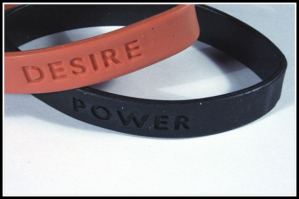
We all want things. That’s what makes life interesting. Fiction, too. Fuel your character’s journey with desire.
What does your character want? It sounds obvious. But looking back, I know I didn’t used to think enough about it. Now, before I write my scenes, I really hone in on the protagonist’s desire. If I am unclear on what it is, I pre-write, have my character speak to me for a couple of hundred words, or throw a few of my people together and let them have a conversation.
It’s good to be aware of both what the character wants throughout the entire story and what the character wants in the scene/chapter you’re working on. As Kurt Vonnegut said: “Every character should want something, even if it is only a glass of water.”
Not wanting something/dreading something can work well too. But, as I always tell my kids, when you focus on what you want, instead of what you don’t want, the results will be so much better!
There is another level of desire for the writer to be aware of: what your character thinks he or she wants. vs. what your character really wants. And why. That’s something else to know.
Finally, a good story is populated with people, all sorts of wonderful, terrible, flawed people, right? The more desires those people have, the more alive and real they will feel to both the writer and the reader. So, get to know your people’s secret (or not so secret) wishes. Then place them into your scenes, sit back and watch, as their desires clash and propel your story forward.
TRUTH
I credit one of my workshop advisors from January, the wise and generous Kathi Appelt, with opening my eyes up to the idea of a character’s “truest truth.” Every character — and I think maybe every person – should have at least one, a big one. Take a moment now to think: what is one thing you believe in with your entire being? What is one truth you could stake your life on? 
And then do the same for your characters. Maybe he believes in the power of music. Maybe his belief is that life is not fair. Maybe her belief is that her physical beauty will carry her through. Or that her mom is perfect. Or that dragons exist, or that there is no God, or that global warming will one day kill us all, or that one day, she will sprout wings, that one day she will fly. (That last one’s from Castle of Concrete, my debut novel  ). Do you see? The belief can be wise or misguided, positive or negative. But characters are much more interesting when they believe in something.
). Do you see? The belief can be wise or misguided, positive or negative. But characters are much more interesting when they believe in something.
Also keep in mind, belief is subject to change. When the character’s innermost belief is shattered by the challenges and events that have been pushing your story forward all along, it turns into an unforgettable moment that transforms your protagonist, and ideally, your reader.
CHANGE 
Of course your main character must change in the course of the novel. An interesting main character will also affect change on others around him. But keep change in mind on scene and chapter level as well, as you write, plot or revise your story. In every single scene something should happen. Which is another way of saying, in every single scene, a change must occur. Or it’s not a scene at all. Just as with desires, changes come in two varieties: internal and external. Here is what I do for every scene, especially when revising (not always when rough drafting, where I explore more):
I write down an Outer Turning Point and an Inner Turning Point for each chapter. Sometimes, by the way, there are more than one. An outer turning point deals with external action, (anything from witnessing a car accident, to leaving the room, to finding treasure), while an inner turning point shows a shift in thought or feeling: for example a change from hope to despair, or a shift in awareness (he will never like me; I am wasting my time). Being aware of these changes helps prevent the characters from constantly see-sawing, or flip-flopping, in their feelings and decisions. (As in: now she likes him, now she doesn’t, now she likes him again). Sure, sometimes a character might change his mind, but it happens in a series of inner and outer turning points building on each other, building into an arc, a progression of change and growth that feels true.
Also, sometimes when I am revising, I’ll copy the first sentence of my scene, and the last, and look at them together. This is a very telling exercise. If you do this, you’ll know right away if there was change or growth in your chapter. You will know whether it was cohesive, or if it falls flat.
So, that’s it. Desire, truth and change.
If your scene loses momentum, or your story does, go back to those three pillars.
These are good to keep in mind for real life as well.
In human experience, desire, truth and change mean everything — or at least they should. As we live out our lives, let’s never be lulled by the daily routine, by the sameness of days and weeks and years, into forgetting our own truths and desires, and change — good change – will take care of itself!
Don’t Miss Reading Katia’s Post Titled, What I’ve Learned At VCFA Series: Semester One (Included: The Secret To Productivity!)
Katia talks about writing and history, and occasionally features interviews and all kinds of lists on her blog, The Magic Mirror, www.katiaraina.wordpress.com.
Talk tomorrow,
Kathy
Filed under:
Advice,
article,
demystify,
Writing Tips Tagged:
Castle of Concrete,
Katia Raina,
Namelos,
Three Pillars of Fiction,
Vermont College of Fine Arts 

 This isn’t a quote, it’s an entire speech.
This isn’t a quote, it’s an entire speech.
This is the commencement address from my graduation at the Vermont College of Fine Arts. It’s given by the brilliant and articulate, Martine Leavitt, and it captures the dedication, heart, and love it takes to write. A large portion of the address relates to going to VCFA in particular, but the larger themes will resonate with any writer.
Here’s a teaser:
“… These are the best reasons to do anything in life. People who say things like this are the kind of people who change the world. Who prevent the world from ending. Or at least they can change the inner world of a reader and that is a sacred power.” - Martine Leavitt
I highly suggest taking some time to watch this video:
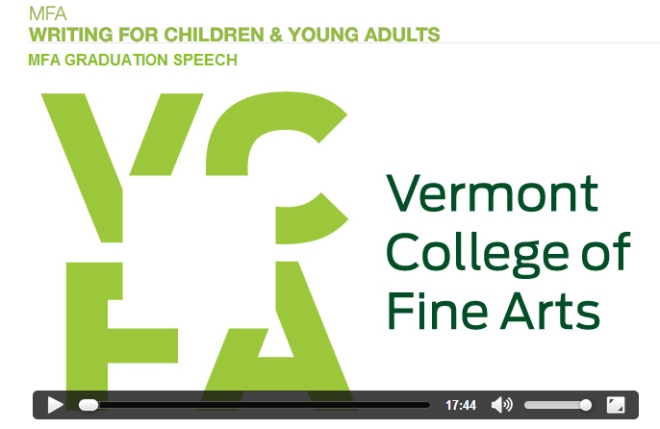
If the image link above didn’t work, please try:
VCFA Graduation Website Link
Martine Leavitt is an American-Canadian author of many books for young adults, including My Book of Life by Angel, Tom Finder, and Heck Superhero. Her novel Keturah and Lord Death was a National Book Award finalist in 2006. She is a faculty member at the Vermont College of Fine Arts, and the mother of seven children.


 This isn’t a quote, it’s an entire speech.
This isn’t a quote, it’s an entire speech.
This is the commencement address from my graduation at the Vermont College of Fine Arts. It’s given by the brilliant and articulate, Martine Leavitt, and it captures the dedication, heart, and love it takes to write. A large portion of the address relates to going to VCFA in particular, but the larger themes will resonate with any writer.
Here’s a teaser:
“… These are the best reasons to do anything in life. People who say things like this are the kind of people who change the world. Who prevent the world from ending. Or at least they can change the inner world of a reader and that is a sacred power.” - Martine Leavitt
I highly suggest taking some time to watch this video:

If the image link above didn’t work, please try:
VCFA Graduation Website Link
Martine Leavitt is an American-Canadian author of many books for young adults, including My Book of Life by Angel, Tom Finder, and Heck Superhero. Her novel Keturah and Lord Death was a National Book Award finalist in 2006. She is a faculty member at the Vermont College of Fine Arts, and the mother of seven children.


 It’s official. I’ve graduated from the Vermont College of Fine Arts with an MFA in writing for children and young adults! It’s been a vigorous and wonderful writing adventure and I’m proud of all that I’ve achieved.
It’s official. I’ve graduated from the Vermont College of Fine Arts with an MFA in writing for children and young adults! It’s been a vigorous and wonderful writing adventure and I’m proud of all that I’ve achieved.
My final residency was glorious (I love this community), stressful (I had to give my own lecture and reading), endlessly inspiring and a fabulous send off into the next stage of my writing life. There’s always more to learn, but I look forward to applying all the tools I now have. The following are a few final tid-bits of writerly advice that I gleaned from my last residency.
Highlights From My Final VCFA Residency:
The Writing Process:
- Writing is messy, magical, hard, and requires a daily leap of faith.
- A novel is a hundred ideas or threads that are all braided together.
- You don’t have to write a perfect sentence every time.
- There is danger in rushing toward the fun bits of our story. Slow down.
- Self congratulatory cleverness can be lethal.
- Several things can be true at once. There are no universal truths when it comes to writing.
- You can’t hide from pain if you want to evoke pain. Sometimes the fear of censorship is really about protecting yourself from being vulnerable.
In Regard to Your Reader:
- Don’t tell your reader everything. Give them 2 + 2, but don’t give them 4. Make them work for it and become involved in the story.
- Tension happens on the page between your characters. Suspense happens between the pages, it’s the interaction of the reader and the book.
- Look for the illusive quality of your work, the weight and felt presences. The ghost within the work that the reader will feel but not articulate.
- Do your character’s choices empower your reader?
- If you were telling your story out loud in front of a group of 10-year-olds, what would you keep and what would you cut? You’d probably cut more than you think.
On Plot:
- Ask yourself what charge every action in your story carries.
- What is the promise whispered to your reader in the first pages? Can/does your story fulfill that promise?
- Every novel starts with a coincidence, after that no other coincidence will be believable!
- At the end of the book we are looking for catharsis, redemption, that “good cleaned out feeling.”
 On Writing Picture Books:
On Writing Picture Books:
- Look for contrasts and opposites when you write a picture book.
- Sometimes we know how a book ends, but it is the HOW that is important. How do we get there is what will bring a kid back for re-reading.
- Animal characters can be easier to access for kids, because they aren’t influenced by gender, race, etc.
- Pack your sentences. Say more with less.
A VCFA residency is full of a thousand musings, genius thoughts, inspirational quotes, and new ways to think about craft! I will dearly miss my bi-yearly residencies. Thank you to all the faculty, students, alumni, administrators, and friends that make this amazing education possible! It’s been a wild and wondrous ride.
Now… to the writing cave!


 It’s official. I’ve graduated from the Vermont College of Fine Arts with an MFA in writing for children and young adults! It’s been a vigorous and wonderful writing adventure and I’m proud of all that I’ve achieved.
It’s official. I’ve graduated from the Vermont College of Fine Arts with an MFA in writing for children and young adults! It’s been a vigorous and wonderful writing adventure and I’m proud of all that I’ve achieved.
My final residency was glorious (I love this community), stressful (I had to give my own lecture and reading), endlessly inspiring and a fabulous send off into the next stage of my writing life. There’s always more to learn, but I look forward to applying all the tools I now have. The following are a few final tid-bits of writerly advice that I gleaned from my last residency.
Highlights From My Final VCFA Residency:
The Writing Process:
- Writing is messy, magical, hard, and requires a daily leap of faith.
- A novel is a hundred ideas or threads that are all braided together.
- You don’t have to write a perfect sentence every time.
- There is danger in rushing toward the fun bits of our story. Slow down.
- Self congratulatory cleverness can be lethal.
- Several things can be true at once. There are no universal truths when it comes to writing.
- You can’t hide from pain if you want to evoke pain. Sometimes the fear of censorship is really about protecting yourself from being vulnerable.
In Regard to Your Reader:
- Don’t tell your reader everything. Give them 2 + 2, but don’t give them 4. Make them work for it and become involved in the story.
- Tension happens on the page between your characters. Suspense happens between the pages, it’s the interaction of the reader and the book.
- Look for the illusive quality of your work, the weight and felt presences. The ghost within the work that the reader will feel but not articulate.
- Do your character’s choices empower your reader?
- If you were telling your story out loud in front of a group of 10-year-olds, what would you keep and what would you cut? You’d probably cut more than you think.
On Plot:
- Ask yourself what charge every action in your story carries.
- What is the promise whispered to your reader in the first pages? Can/does your story fulfill that promise?
- Every novel starts with a coincidence, after that no other coincidence will be believable!
- At the end of the book we are looking for catharsis, redemption, that “good cleaned out feeling.”
 On Writing Picture Books:
On Writing Picture Books:
- Look for contrasts and opposites when you write a picture book.
- Sometimes we know how a book ends, but it is the HOW that is important. How do we get there is what will bring a kid back for re-reading.
- Animal characters can be easier to access for kids, because they aren’t influenced by gender, race, etc.
- Pack your sentences. Say more with less.
A VCFA residency is full of a thousand musings, genius thoughts, inspirational quotes, and new ways to think about craft! I will dearly miss my bi-yearly residencies. Thank you to all the faculty, students, alumni, administrators, and friends that make this amazing education possible! It’s been a wild and wondrous ride.
Now… to the writing cave!


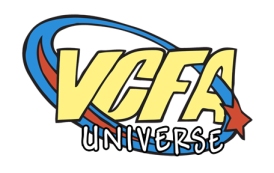 One of the things I love about attending the Vermont College of Fine Arts (VCFA) is the school’s traditions. We name our classes and have class-name “reveal” ceremonies. We decorate the portraits that hang on campus with silly kidlit references. There’s even a costume party themed in honor of the graduating class, and more.
One of the things I love about attending the Vermont College of Fine Arts (VCFA) is the school’s traditions. We name our classes and have class-name “reveal” ceremonies. We decorate the portraits that hang on campus with silly kidlit references. There’s even a costume party themed in honor of the graduating class, and more.
I graduated this week (woohoo!), which meant my class (The Dystropians) had the our honor of introducing the VCFA faculty at our last residency. Per tradition, the presentation is inspired by the graduating class’s name. My class is the Dystropians — a play on Dystopian “end of the world” literature and the literary device of tropes. We named ourselves the Dystropians because we graduated in Jan 2013, having just survived the Dec. 21st 2012 Aztec apocalypse.
With our theme of “rising from the ashes of the apocalypse,” the Dystropians introduced the VCFA faculty as SUPERHEROES who must write, teach, and spread the written word after the end of days.
This all serves as preamble for the fact that I had the honor of drawing all our faculty members as superheroes! And I would like to share them with you.
Thus, I present to you – The VCFA Kidlit Universe!
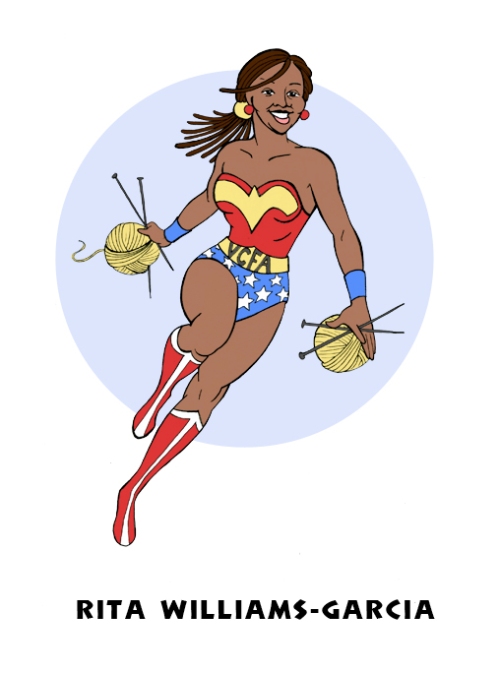
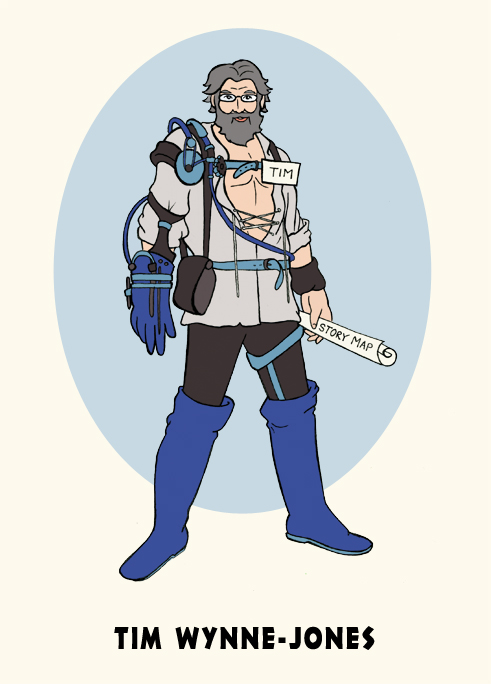
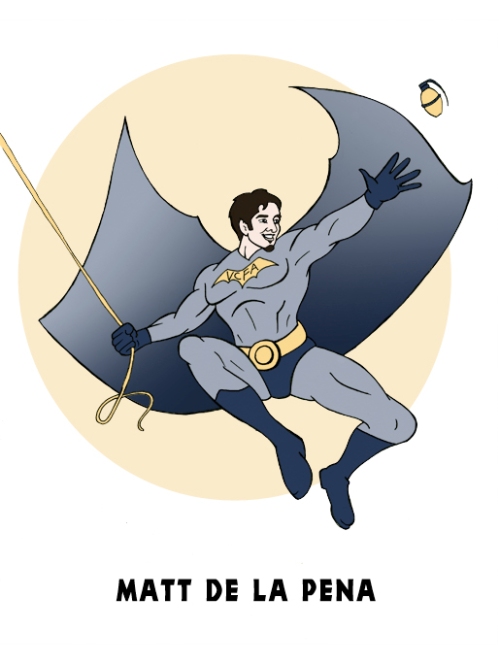
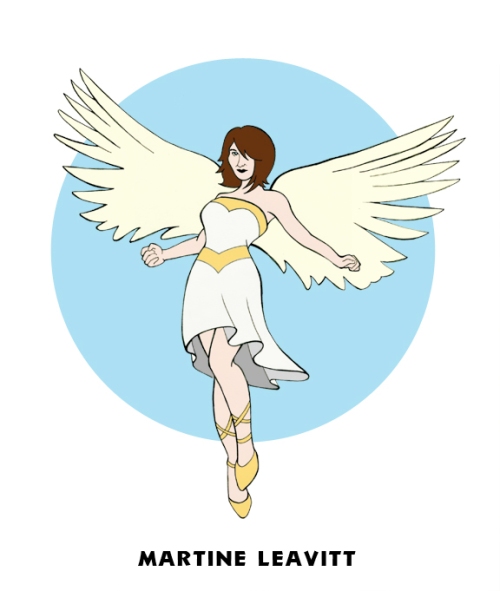
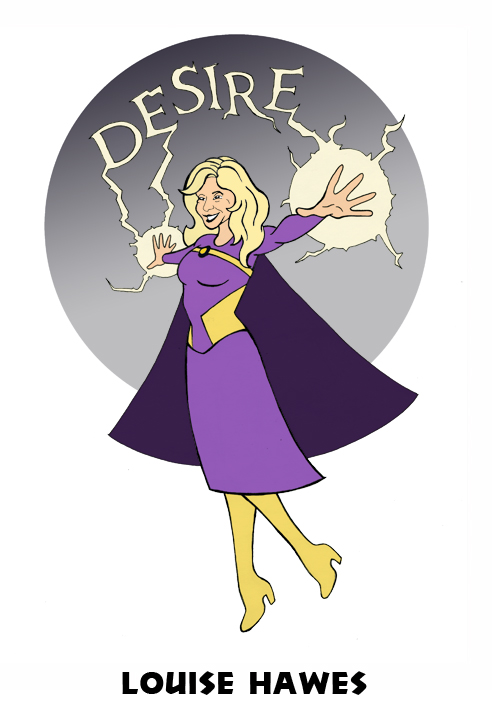
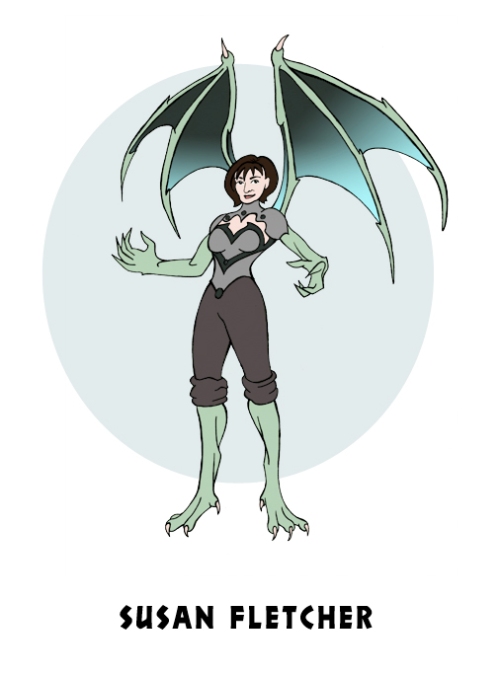
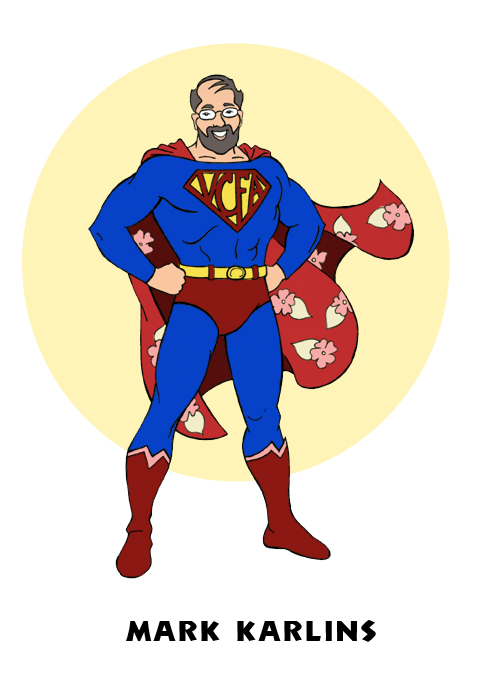
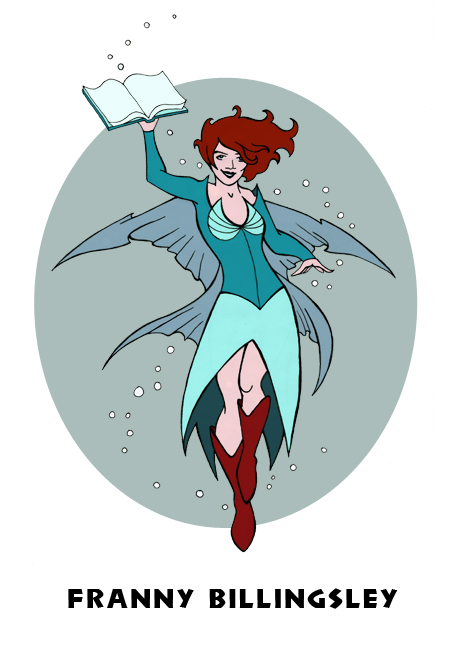

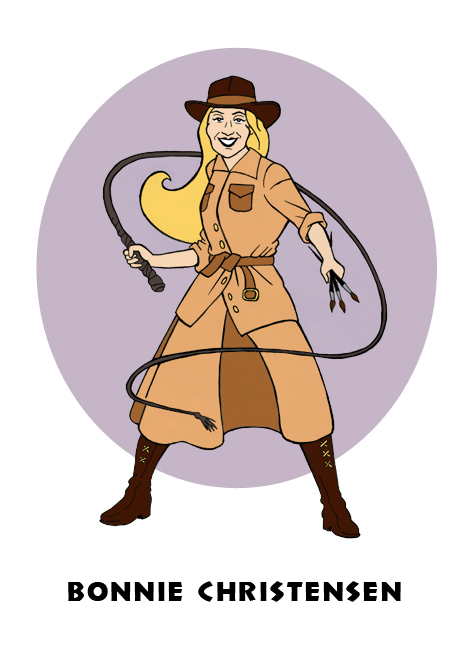
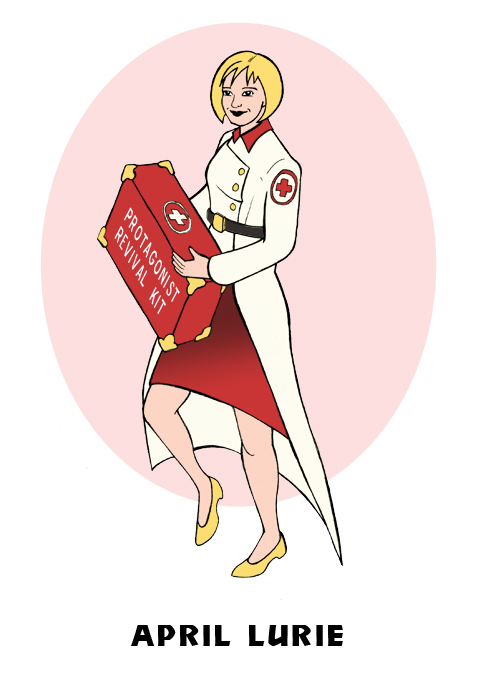
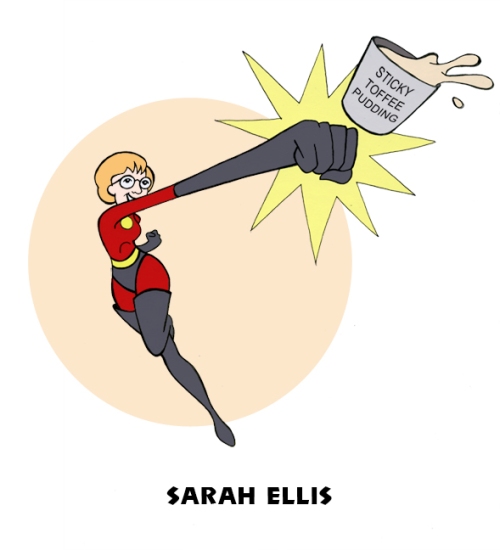
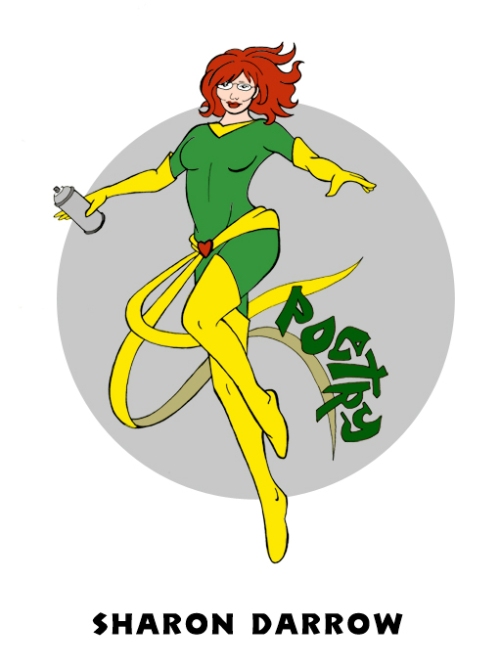
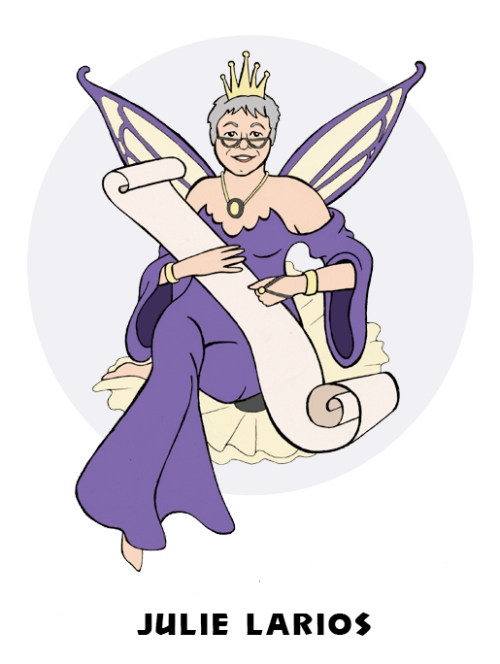
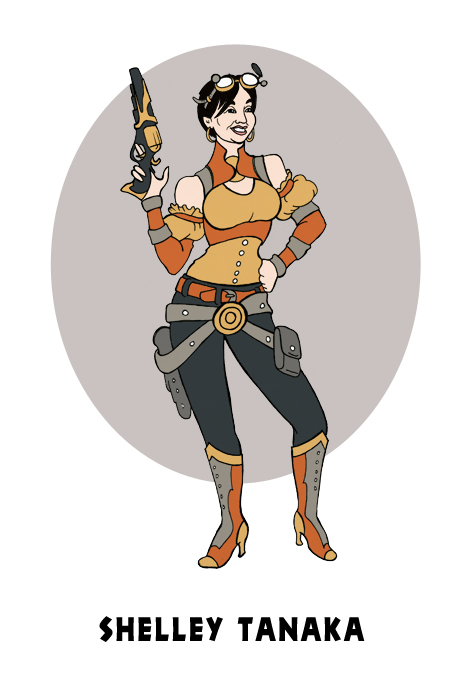

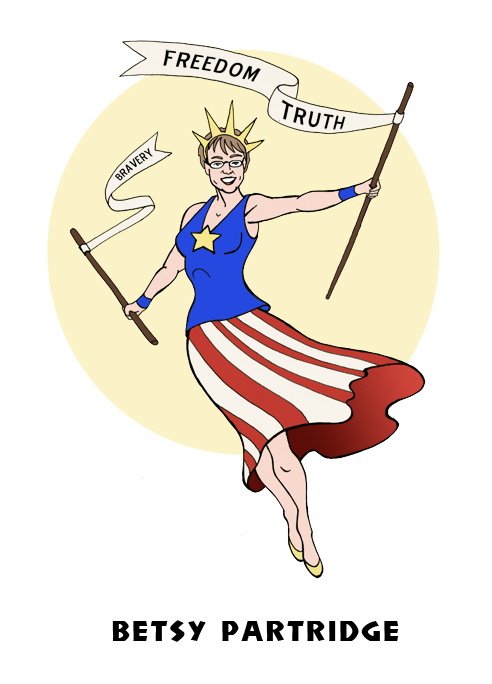
.
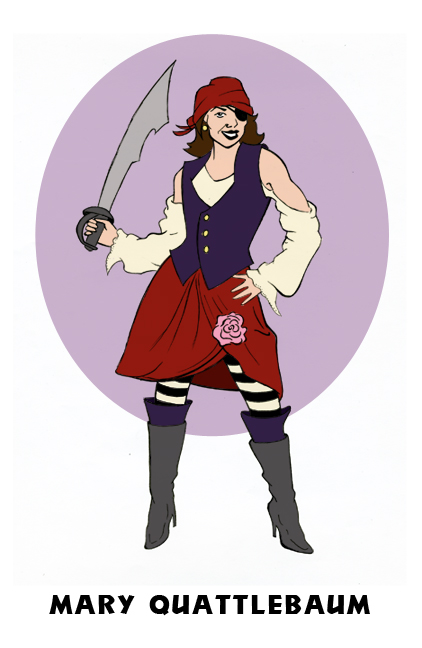

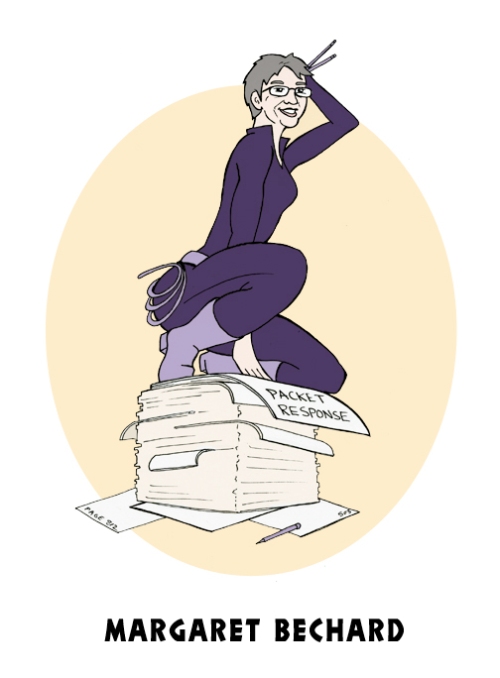
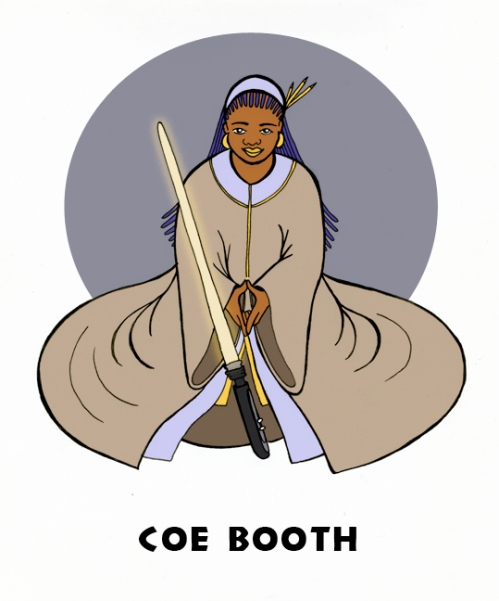
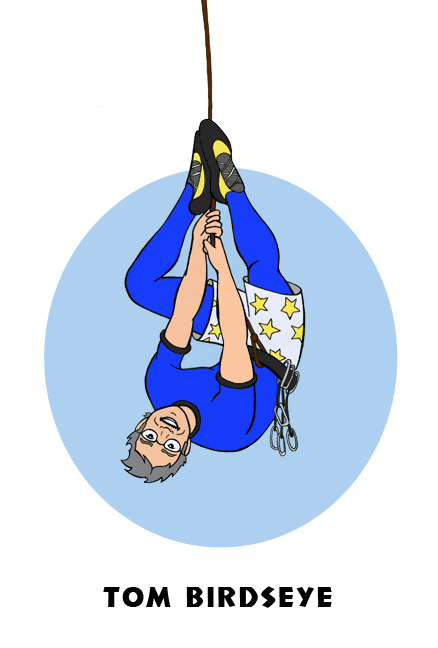
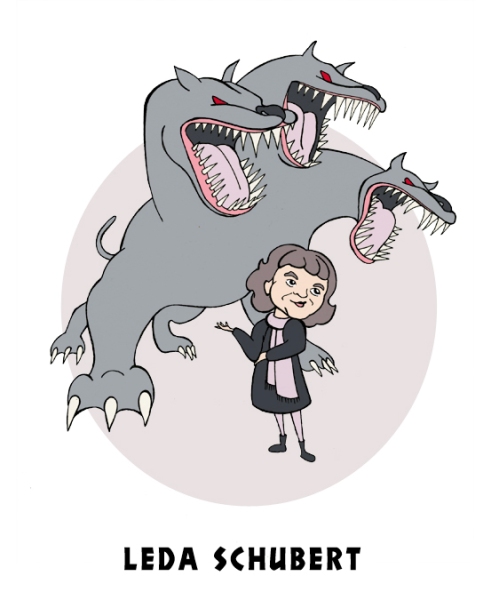
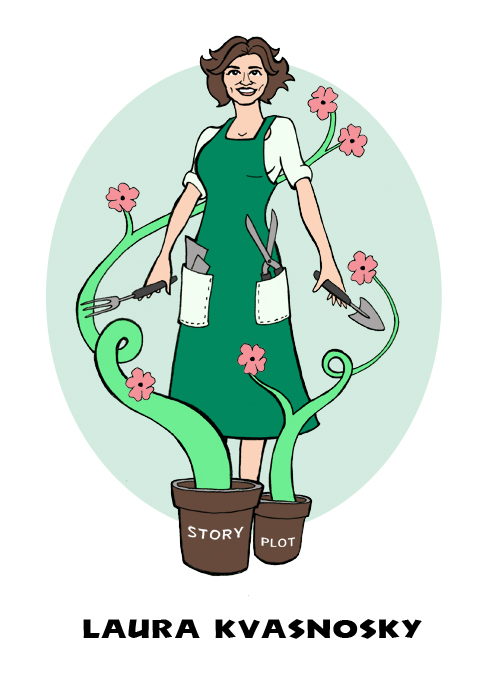

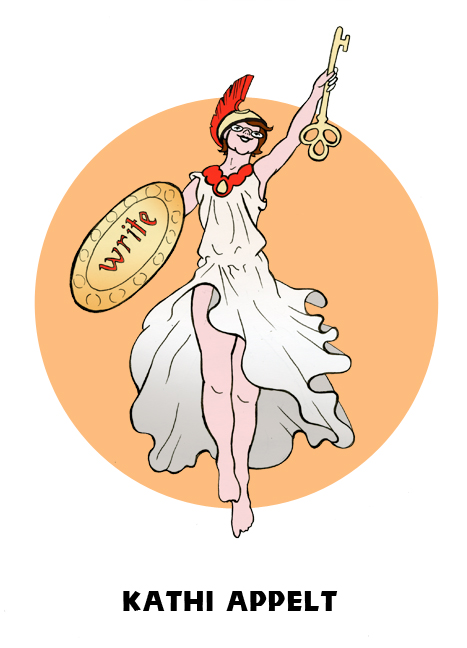
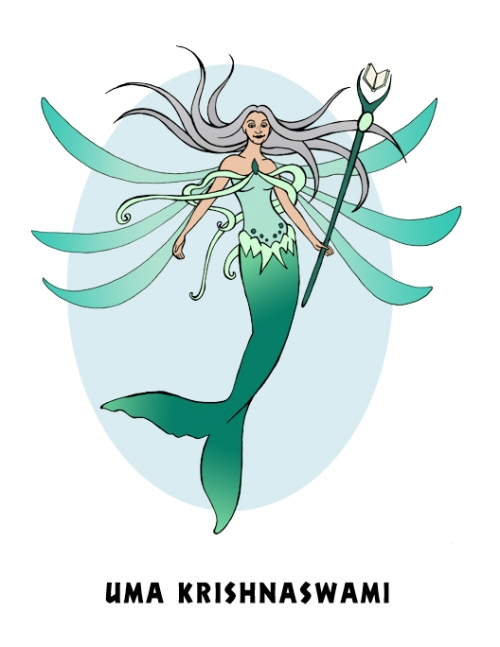
After the apocalypse the future of writing is secured with the Dystropian Task Force!

Illustrations by: Ingrid Sundberg


 One of the things I love about attending the Vermont College of Fine Arts (VCFA) is the school’s traditions. We name our classes and have class-name “reveal” ceremonies. We decorate the portraits that hang on campus with silly kidlit references. There’s even a costume party themed in honor of the graduating class, and more.
One of the things I love about attending the Vermont College of Fine Arts (VCFA) is the school’s traditions. We name our classes and have class-name “reveal” ceremonies. We decorate the portraits that hang on campus with silly kidlit references. There’s even a costume party themed in honor of the graduating class, and more.
I graduated this week (woohoo!), which meant my class (The Dystropians) had the our honor of introducing the VCFA faculty at our last residency. Per tradition, the presentation is inspired by the graduating class’s name. My class is the Dystropians — a play on Dystopian “end of the world” literature and the literary device of tropes. We named ourselves the Dystropians because we graduated in Jan 2013, having just survived the Dec. 21st 2012 Aztec apocalypse.
With our theme of “rising from the ashes of the apocalypse,” the Dystropians introduced the VCFA faculty as SUPERHEROES who must write, teach, and spread the written word after the end of days.
This all serves as preamble for the fact that I had the honor of drawing all our faculty members as superheroes! And I would like to share them with you.
Thus, I present to you – The VCFA Kidlit Universe!

















.










After the apocalypse the future of writing is secured with the Dystropian Task Force!

Illustrations by: Ingrid Sundberg



By: Kathy Temean,
on 12/25/2012
Blog:
Writing and Illustrating
(
Login to Add to MyJacketFlap)
JacketFlap tags:
Author,
Newbery Medal,
list,
Horn Book,
article,
Vermont College of Fine Arts,
need to know,
Gwen Connolley,
Katia Raina,
Shelly Tanaka,
Add a tag
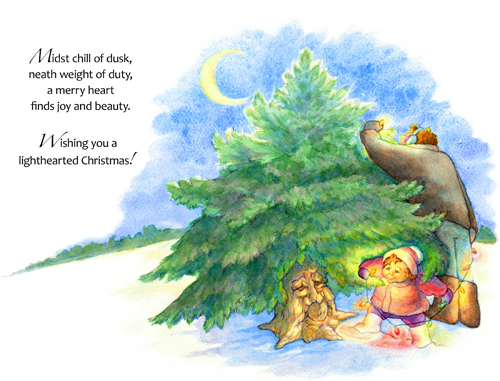
This Christmas card was sent in by Gwen Connolley.
Even before the recent nightmare in Connecticut, the spirits of many seemed a bit dampened for the holidays this year. Sometimes it can require effort, at least for us grown ups, to see beyond our troubles and discover that simple joys can be found even in dark or stressful times. I think most holidays were created by and for those who need to find reason to be joyful in otherwise dire times. I would like to encourage others to seek and to find that life and light and love perpetually surround us. You can find more of my illustrations at www.gwenconnolley.com
Best wishes to you for the holidays and in the coming new year!
Names All Children’s Writers Should Know How To Spell: A Tribute to Kidlit Greatness
Though the below descriptions/explanations are mine, this list is from a lecture by Shelley Tanaka, an award-winning nonfiction children’s author, Canadian children’s book publisher and editor (link: http://en.wikipedia.org/wiki/Shelley_Tanaka).
In preparation of starting my studies at the Vermont College of Fine Arts in pursuit of an MFA in Writing for Children and Young Adults in less than a month from now, I came across a handout from one of my teachers, Shelley Tanaka, which, with her gracious permission, I would like to share with you. This list is more than a checklist of names with tricky spellings – although it’s that too. It is a reminder of our roots as children’s writers. These are the names of the great kidlit warriors, whose shoulders we are all trying to stand on.
(Note: Don’t feel bad if you don’t know all of them. I had to look up a couple!)
- Newbery Medal. Named after an English bookseller John Newbery, the medal aims to recognize excellence in young people’s literature.
- Hans Christian Andersen. Yes, we all know the wonderful andwhimsical storyteller from Denmark – author of numerous fairytales, novels, poetry and more — but some of us sometimes confuse his name with Anderson, as in M.T. Anderson, another name to know in young people’s literature, by the way).
- Noel Streatfield. A Carnegie-medal winning English author.
- Katherine Paterson. The beloved author of many young adult and children’s novels, including my personal favorite, Newbery-winning “Bridge to Terabithia.”
- Stephenie Meyer. Some in kidlit circles like to look down on this author of the wildly popular “Twilight” saga. But she has definitely proved herself a force to be reckoned with, luring millions of girls to her romance with a vampire. Did you know that in addition to writing, Meyer is a film producer? Her production company is behind a movie based on Shannon Hale’s adult work, “Austenland.” (Yes, Shannon Hale’s another great one.)
- Kate DiCamillo. Best known as theNewbery-winning author of sometimes tender, sometimes whimsical fiction for children, DiCamillo has also written picture books, early chapter books and published stories for adults.
- Diana Wynne Jones. Born in London in 1934 and having passed away just last year, Jones was best known for her numerous fantasy novels for children and adults.
- Ursula K. Le Guin. This author of several popular children’s series (as well as standalone stories), was a huge influence on many of the fantasy and science-fiction novels we read today.
- Kenneth Grahame. This Scottish author wrote such children’s classics as “The Wind and The Willows,” and “The Reluctant Dragon,” both of which became Disney films.
- Rosemary Sutcliffe. This British novelist was best known for her exciting historical fiction for young readers – especially her Arthurian stories (some of which were for adults).
- Arthur Ransome. Another Englishman, considered one of the classic children’s authors, best known for his “Swallows in Amazons” adventure series set in between two world wars.
- J. R. R. Tolkien. Though he didn’t write for children specifically, one could easily call him one of the founding fathers of fantasy, influencing such modern works as the “Harry Potter” series by Tolkien’s fellow Englishwoman J. K. Rowling (and yes, I trust we’ve all heard about her, and know her name’s spelling). Though of course fantasy was written before his time, it seemed his “Lord of the Rings” series resurrected the once-dying genre.
- Madeleine L’Engle. Much beloved and missed, this American Newbery-winning author passed away in 2007. In her obituary, the New York Times described her work as “childhood fables, religious meditations and fanciful science fiction” that “transcended both genre and generation, most memorably in her children’s classic ‘A Wrinkle in Time.’”
(link: http://www.nytimes.com/2007/09/08/books/08lengle.html?pagewanted=all&_r=0)
I love the quote on her website: “You have to write the book that wants to be written. And if the book will be too difficult for grown-ups, then you write it for children.”
- Horn Book. This magazine publishes articles about trends in children’s and young adult literature in print and online, including its influential reviews. Each year, the staff chooses a list of what they considered to be the very best titles from among 500-plus books they have reviewed. (link: http://www.hbook.com/2012/12/choosing-books/recommended-books/2012-horn-book-fanfare/)
There are two more I’d like to add to this list:
15. Laurie Halse Anderson. Another great author name with literary spelling, this versatile YA giant writes books on difficult subjects spanning from rape and anorexia, to slavery.
16. SCBWI! Founded in 1971, by several Los Angeles writers, including the versatile Stephen Mooser, author of more than 50 works, including picture books and chapter books, and the middle-grade series author Lin Oliver, our beloved Society of Children’s Writers and Illustrators is a source of knowledge and support, organizer of conferences and forger of great ties, and a promoter of children’s literature all around the world.
Of course this list only barely scratches the surface, and if she chose to Ms. Tanaka could probably have come up with a book filled with names of importance. But if there is anything you’d like to add to the list, please post a comment, below.
Katia Raina is the author of “Castle of Concrete,” a young adult novel about a timid half-Russian, half-Jewish teen in search of a braver “self” reuniting with her dissident mother in the last year of the collapsing Soviet Union, to be published by Namelos. On her blog, The Magic Mirror, http://katiaraina.wordpress.com Katia talks about writing and history, features interviews, book lists and all sorts of literary randomness.
Katia will start her MFA program in January 2013 at the Vermont College of Fine Arts, pursuing a degree in Writing for Children and Young Adults. (link: http://www.vcfa.edu/wyca)
Talk tomorrow,
Kathy
Filed under:
article,
Author,
list,
need to know Tagged:
Gwen Connolley,
Horn Book,
Katia Raina,
Newbery Medal,
Shelly Tanaka,
Vermont College of Fine Arts 

 I’ve made it back from my second VCFA residency!
I’ve made it back from my second VCFA residency!
I’m exhausted, inspired, in love with my class, and ready to dig in to a new semester of writing. Overflowing with insight and inspiration, I’m hoping the acclimation process (back to “normal” life) is slow and tender. In the meantime, I thought I’d share a few quick take-away’s from the last eleven days of stick-toffy-pudding-VCFA-Awesomeness!
1. Never let your character’s cry more than once in a manuscript! If you do, you’re being too sentimental and force feeding your audience sticky-toffy-pudding (which is just too sweet).
2. Writing a picture book is not just about the text. You must leave room for the illustrator, but you must also leave room for the performer!
3. When writing multi-cultural literature, beware of perpetuating the one story that speaks for a culture. There is never a single story that encapsulates a whole group of people.
4. Trust your readers to pick up on the clues and details you leave for them. Trust your audiences ability to intuit.
5. Learn to hesitate, question the nature of things, and be the writer who creates riddles out of answers. Sometimes the questioning, the searching, and the ability to see things a-new is more the profound than finding an answer.
6. It’s not always about “show not tell.” Sometimes, careful and informed telling can deepen the showing.
7. Beware the abstract word. Be specific and vivid. “Beautiful” is abstract and means nothing. We want a world with pearl buttons, spiced rum, and creased wax paper.
8. The metaphorical is sexy! Discover the action of your story by finding the metaphor for the emotional core of your story.
9. The landscape of your story is not just place and earth and dirt. The landscape of your story is overlain with memory, expectation, and thought.
10. There are lots of not-so-good books that get published. The reason they are published is because the author FINISHED THE BOOK! You can talk all you want about writing, but until you finish your book, your writing will never get published.








10 Comments on
The VCFA Sticky Toffy Pudding Take-Away, last added: 7/23/2011
The
TeachingAuthors are proud to be part of the
Vermont College of Fine Arts (VCFA) Summer Blog Initiative. We're especially pleased to be the first blog to feature these inspiring and practical posts by students and graduates of the MFA programs because four of the
TeachingAuthors (
Jeanne Marie Grunwell Ford,
Carmela Martino,
Mary Ann Rodman, and me,
JoAnn Early Macken) hold MFAs from Vermont College. On Monday, our series began with Jodi Paloni's entry,
"The Point of Point of View." In Wednesday's guest post,
"Decide vs. Discover," Cynthia Newberry Martin shared a technique for letting the characters tell you what happens next in your story. Today, Sion Dayson gives us another method for moving forward.
What Happens Next? Inch Forward in the Dark, by Sion Dayson
Working on my first novel, I sometimes felt like I was stumbling through a large, strange house without the benefit of light. Maybe a storm cut the power or faulty wiring flipped the switch. Whatever the reason, I was in the midst of a blackout, trying to draw a blueprint of a place I had never been.
My advisor
Ellen Lesser had a simple suggestion for combating the panic of not knowing where I was heading in my writing: inch forward in the dark.
The directive resonated.
I connected it to my idea of the foreign house. Everything was already there to be discovered; I just couldn’t see it yet. So I’d run my hands along the walls, stretch my arms out in front of me, take tiny steps. I inched forward in the dark. I learned there was a chair in the middle of the room, a desk with knick-knacks in the corner. What was this? Perhaps family portraits on the mantle?
After awhile I found a light switch. Suddenly an entire room was visible. It looked different than what I’d pictured, yet it was also so clear. Of course, this is the kitchen, I might say. Utensils on the drying rack, chipped plates, a leaking sink I’d heard when the lights were out--though I’d been unsure of its source.
But the hallway remained dark. The bedroom, the den. So I just kept mapping the house (the story) until every lamp was lit. Warm light seeped from each window. Slowly, I started making myself at home.
Sion Dayson will graduate in July 2011 with an MFA in Fiction Writing from Vermont College of Fine Arts. Her work has appeared in Smokelong Quarterly, a National Book Foundation anthology, and the volume "Strangers in Paris," among other venues. She is currently working on her first novel. If you have any questions about her post or the MFA program at Vermont College, you can contact Sion directly at [email protected]. Feel free to visit her blog paris (im)perfect for information on her writing journey and other adventures in the City of Light.
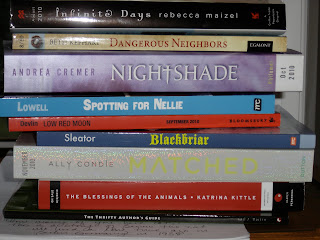
Last week was extremely busy. It started on Monday with the Jewish Book Network's Meet the Author Day. On Tuesday, my last packet for the semester was due. Wednesday and Thursday were BEA, and Friday was a day of rest. And boy, did I need it!
The Jewish Book Network's Meet the Author Day was more like Meet the Author's Hour. It was in NYC, which for me is only a quick drive away, but, of course, traffic was horrid going over the George Washington Bridge and down the FDR Drive. But being compulsive, I'd left myself enough time and wasn't late. The day consisted of 25 children's book writers who had written Jewish themed books, giving in a 2-minute presentation through which we were to "sell" ourselves and our books to members of the Jewish community who might want to invite us to their synagogues, JCCs, day schools, religious schools, whatever. There were 25 of us and we went in alphabetical order, so . . . you got it, I went last. After an hour of sitting in a hot room with my anxiety climbing the wall, I finally got up to speak, but I had no voice. I then proceeded to have a coughing fit. I was given a drink of water and told that 5 seconds had been added to my time (all in jest of course). I have no memory of what I said after I drank the water. For all I know I spoke in tongues. After the presentations were over, we got to schmooze with the attendees and had some lunch. All of which was quite nice. Then I drove home and, of course, traffic was horrid up the FDR Drive and across the GW bridge.
On Tuesday, I had to send in my last packet of work to my VCFA advisor. I did so with mixed feelings. Part of me was thrilled to be finishing what was a challenging but productive semester, and part of me was sad to be ending my work with Alan Cuymn. Alan had been a demanding advisor. He encouraged me not only to revise the opening of my wip, but to start it over fresh for every single packet (there are five packets). To say that I was sick of the opening of my story after this semester would be false. Alan forced me to slow my writing process down, to really hook the reader in the opening few pages, and to set up the story properly so that most readers would have no problems believing the premise I was creating. Alan's comments and suggestions were right on and with every rewrite the opening got stronger and better. How could I be upset with such an outcome?
Wednesday was Book Expo America. I have never been to one of these before. If you have never been, you should. What an experience! It was held in the Jacob Javits Center. The place was filled with publishers from around the world hawking their wares and thousands of librarians, teachers, writers, editors, publishers, and people who love to read wandering around. It was overwhelming, fascinating, claustrophobic, and thrilling. I meet several fellow VCFA students, including my roommate Kathleen Wilson . We wandered through the booths gathering a stack of ARCs. Yes, the publishers do literally throw books at you as you pass. I gathered a stack of ARCs I am anxious to read (see photo above), the first being Infinite Days by fellow VCFA student Rebecca Maizel. It was a fun and exhausting day. So exhausting that I couldn't go back on Thursday. After everything else going on that week, I was done.
This week is filled with my usual life. And next week we are going on vacation! The whole family - our
In January at Vermont College of Fine Arts, I helped facilitate a discussion on non-fiction books including Charles and Emma and Claudette Colvin, which got me thinking about stories that entertain as well as inform. As a novelist who’s also written her share of non-fiction, I’ve long been interested in the relationship between fact and fiction for writers.
How do you best tell a story that opens up new worlds of science or industry to young readers? This week three authors with new releases join us for in depth conversations about their own relationship between fiction and non-fiction, and the literary process.
Vicki Wittenstein, author of the non-fiction book on astronomy, Planet Hunter, Jacqueline Houtman, science writer and author of the new novel The Reinvention of Edison Thomas, and author and writing teacher Leda Schubert, whose picture book about making wool Feeding the Sheep is being released by Farrar Straus Giroux.
First, congratulations Leda!
Leda Schubert is author of several books for children including Ballet of the Elephants (Roaring Brook, 2006) and Here Comes Darrell (Houghton, 2005) and teaches at Vermont College of Fine Arts where she lends a warm and wise presence, and can always be counted on to liven things up with a little humor.
She’s been a librarian, teacher and school library consultant for the Vermont Department of Education and has served on the Caldecott Committee, the Arbuthnot Committee, the Boston Globe-Horn Book Committee, among others. Mor












 Katia Raina is the author of “Castle of Concrete,” a young adult novel about a timid half-Russian, half-Jewish teen in search of a braver “self” reuniting with her dissident mother in the last year of the collapsing Soviet Union, to be published by Namelos.
Katia Raina is the author of “Castle of Concrete,” a young adult novel about a timid half-Russian, half-Jewish teen in search of a braver “self” reuniting with her dissident mother in the last year of the collapsing Soviet Union, to be published by Namelos.





































 10 Comments on The VCFA Sticky Toffy Pudding Take-Away, last added: 7/23/2011
10 Comments on The VCFA Sticky Toffy Pudding Take-Away, last added: 7/23/2011




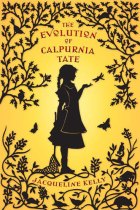

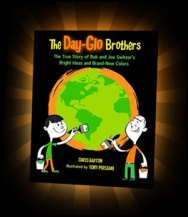
That’s great stuff, Katia! Thanks for posting this, Kathy; I’m now following Katia I love tips like looking at the first and last sentences of a scene together.
I love tips like looking at the first and last sentences of a scene together.
Thank you, Donna, for following. I am so glad you found the post helpful. And Kathy, thanks for sharing. I will try to come up with some guest posts for you at some point. I still really want to, though things are pretty insane right now. The program sure keeps me busy
Absolutely a great article, Katia! Thanks for sharing!
Wonderful article, the information was very cohesive! Thanks Katia and Kathy for sharing it.